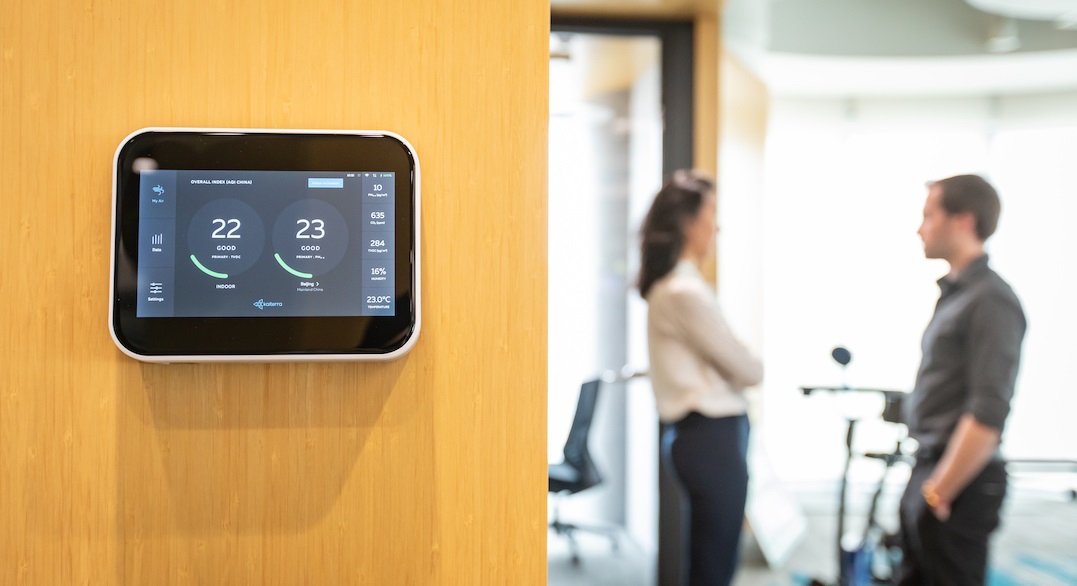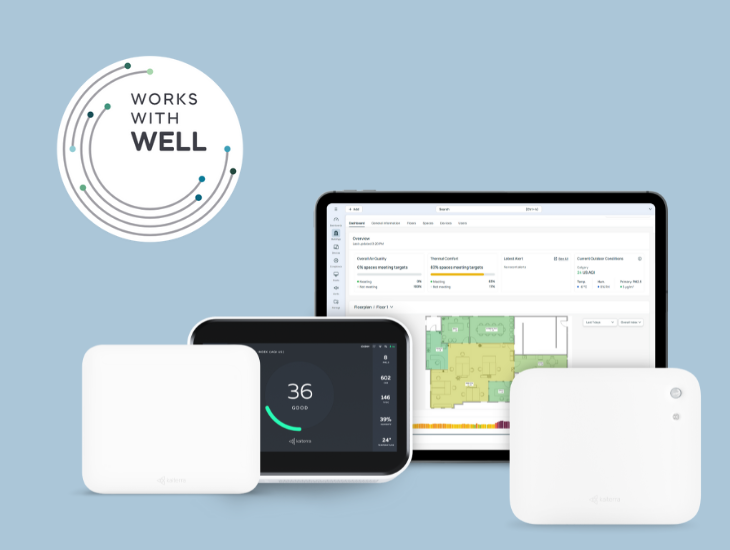Newsletter
Workplaces affect human health in different ways. As the World Health Organization website notes, “Work is good for mental health but a negative working environment can lead to physical and mental health problems.” How can businesses ensure that their offices are conducive rather than detrimental to health?
In this article, we’ll explain how poorly-designed workspaces hurt both employees and businesses. From there, we’ll dive into the 7 key benefits of healthy buildings when it comes to improving health, wellness, and wellbeing in the workplace.
If you're exploring ways to enhance your workplace experience through improved indoor air quality, you'll want to read our FREE comprehensive guide on IAQ for healthy workplaces. Learn how IAQ data can be leveraged to elevate workplace performance, alleviate employee concerns, and drive better business outcomes:
Employees Are Sick of Sick Buildings
Factors such as work-related stress, difficult work relations, and job insecurity have long been linked to poor health outcomes. But in recent years, research has also shone a spotlight on the health impacts of the buildings in which work happens.
According to the EPA website, Americans spend 90% of their time indoors (and this is based on research from 1989 - it’s safe to guess the digital age has not improved these numbers). Between work and home, we have all become mostly indoor creatures, and our built environment has a direct correlation to our physical and mental wellbeing.
Unfortunately, not all buildings are created equal in this regard. Poor air quality, inadequate ventilation, humidity, noisy offices, and a lack of natural daylight can all contribute to sick building syndrome and negative health consequences for inhabitants. For workers, this can lead to absenteeism, disgruntlement, and inability to focus on the work at hand; for businesses, these translate into lost productivity and inability to retain talent.
Wellness is the New Sustainability
The reality described above is changing, and poor work environments are being transformed for the better. In line with the general societal trend towards healthier lifestyles, many businesses have grown interested in workplace wellness. This can mean scheduled mandatory downtime, increased mental health support, or other programs; and in the context of building and facility management, it’s led to the rise of healthy buildings.
Who stands to benefit from making buildings healthier? Everyone from line-of-business employees to C-suite executives and investors. Steps such as improving ventilation, monitoring air quality, and reducing noise drive tangible benefits in the short and long term:
- Employees enjoy a safer working environment, better morale, and reduced risk of illness
- Employers see productivity gains from a more present and less distracted workforce
- Building owners and companies looking to attract talent can offer a stronger value proposition to an increasingly-selective candidate pool
For these and other reasons, it’s been said that “in building, wellness is the new sustainability.”
Let’s take a closer look at how healthy buildings promote workplace wellness and wellbeing, and what businesses stand to gain.
The 7 Key Benefits of Healthy Buildings for Wellness and Wellbeing at the Workplace
1. Better Overall Health Outcomes for a Healthier Workforce
Sick Building Syndrome can be a major value destroyer for companies. Research has shown that 23% of office workers complain of symptoms such as allergies, respiratory ailments, and asthma - all of which are commonly caused or exacerbated by poor ventilation and indoor air quality. It’s estimated that the accumulated loss of productivity could be as high as $60 billion annually, much of which could be prevented through indoor air quality improvements and other healthy building strategies.
Absenteeism due to illness similarly costs billions in lost productivity, especially among white-collar workers. Can healthy buildings help reduce these losses? Multiple studies have indicated that a healthier indoor environment can lead to a 2% drop in sick leave and a 1.5% drop in overall absenteeism.
2. Improved Cognitive Function for Knowledge Workers
Office employees are knowledge workers: they generate value by using their cognitive abilities to solve problems. As it turns out, healthy buildings can significantly enhance these skills and produce impressive productivity gains.
A team of researchers from Harvard university put this to the test in 2015. In a study summarized in Harvard Magazine, They adjusted ventilation rates, CO2 levels, and airborne volatile organic compounds (VOCs), and performed cognitive assessments of employees at the end of each day. The results? Improving air quality produced a 131% improvement in crisis-response questions, 299% improvement in information usage, and 288% improvement in strategy. The researchers estimated that this could translate into thousands of dollars of increased productivity per employee, annually.
In a separate study, workers in green-certified buildings scored 26.4% higher on cognitive assessments, even when controlling for earnings, job category, and education. Researchers also saw an improvement in sleep quality and a 30% reduction in sick building syndrome symptoms.
3. Better Sleep at Night Leads to Better Days at Work
Sleep is often overlooked in the hectic, perennially busy world we live in, but a good night’s sleep can go a long way. The link between sleep and job performance is well-established, and the loss of productivity associated with poor sleeping has been estimated at $1,967 per employee, annually.
Healthy buildings can help occupants sleep better: an important foundation of healthy buildings is lighting and views, and especially the availability of natural daylight and brightly lit spaces. Multiple studies have shown that lighting affects sleep duration and quality.
One such study, published in 2017, has shown that brighter office lighting was associated with higher sleep scores, with occupants of certified green or healthy buildings averaging 6.4% higher scores than those of non-certified buildings. Separately, a 2019 study has shown that exposure to daylight can increase sleep duration as well as sleep quality.
4. Motivating the Workforce
In addition to the tangible health benefits, it’s easy to see how healthy buildings would improve motivation and morale and contribute to a better workplace experience. Data seems to confirm this intuition: 69% of owners report higher employee satisfaction and engagement following investment in healthy buildings. Similarly, a review of green and healthy-certified buildings found that they received 30% fewer complaints about issues such as air quality and thermal comfort.
Investment in healthy buildings, similar to workplace wellness programs, can elevate the employer brand and demonstrate that the company is committed to its employees. Over time, this can help businesses attract and retain workers - factors that are becoming more important than ever as competition for talent heats up.
5. Better Mental Health Outcomes
A poor work environment can wreak havoc on employees’ mental wellbeing and induce stress, anxiety, and mood disorders. Healthy building best practices can help, in addition to other resources and processes to support employees who struggle.
For example, a healthy building can provide more access to greenery, which has been shown to impact mental health. Similarly, noise is a major stressor, with 44% of employees surveyed reporting that noisy conditions increased their stress levels and hurt their overall wellbeing. Designing offices in ways that reduce background noise, and provide spaces for quiet concentration and contemplation can help alleviate these issues.
6. Less Distractions, More Focus
Many of the things that can make us feel poorly over the long run might appear as mere annoyances or distractions in the short term. In a world full of digital distractions, many are already lamenting the lost art of concentration, and an unhealthy working environment can make things worse.
Noise is a major culprit here as well, with studies indicating that ongoing background noise can lead to the body producing excess cortisol - impairing cognitive functions such as planning, reasoning, and impulse control. Lack of thermal comfort has also been shown to reduce productivity at the office.
Distracted workers accomplish less, and this can also spur demotivation as employees feel that they are “spinning their wheels” without making much progress. Healthy buildings can provide more favorable working conditions and give people the peace and quiet to focus on the task at hand.
7. Easing of Pandemic-related Stress
The last two years have been abnormal times, with the COVID-19 health crisis adding a major source of stress for people everywhere. Employers can play their part in reducing this stress by alleviating the concerns employees have about their health and safety at the workplace
As we’ve discussed in our previous article, healthy buildings play an important role in a post-COVID world. Measures such as ventilation and cleanliness can help to reduce the risk of infection. Equally importantly, they can make workers feel safer, and allow more of them to return to the office without fearing for their wellbeing.
Closing: Healthier, Happier Employees are a Win-Win
Today, more and more companies are realizing that healthy buildings play a crucial role in ensuring the wellness and wellbeing of office workers. As we’ve covered above, the potential benefits of investing in healthy buildings are significant.
Moreover, these investments are a win-win situation, where the interests of employees perfectly align with those of employers: workers in healthy buildings generate more value for the companies that employ them, with productivity gains that are estimated at thousands of dollars per employee annually. The alternative is a sick, demotivated, and frequently-absent workforce, which no one benefits from.
Learn more about how indoor air quality data can be used to enhance the workplace experience, alleviate employee concerns, and drive better business outcomes in our FREE eBook, IAQ for Healthy Workplaces:
Kaiterra provides air quality monitors and an IAQ analytics dashboard for healthy buildings and offices, helping workplace leaders and healthy building pioneers assess and improve their indoor air quality. Our indoor air quality monitors like the Sensedge and the Sensedge Mini can be found in many of the world’s most iconic buildings and workplaces, such as the Empire State Building and the Burj Khalifa.






.png?width=200&height=148&name=Menu%20C%20(2).png)

.png?width=307&height=228&name=Menu%20-%20D%20(1).png)
.png)





